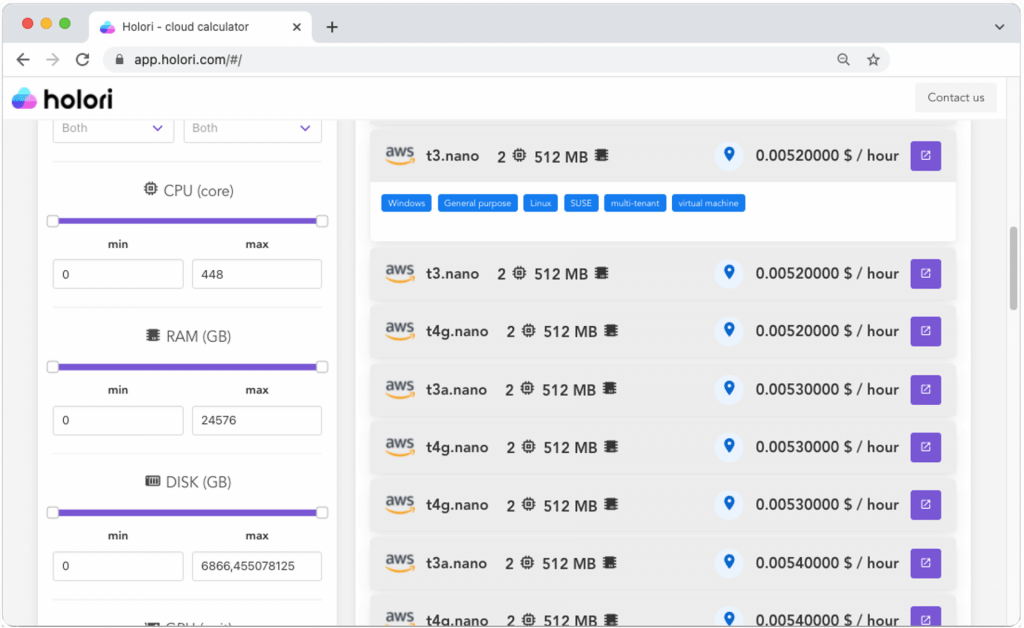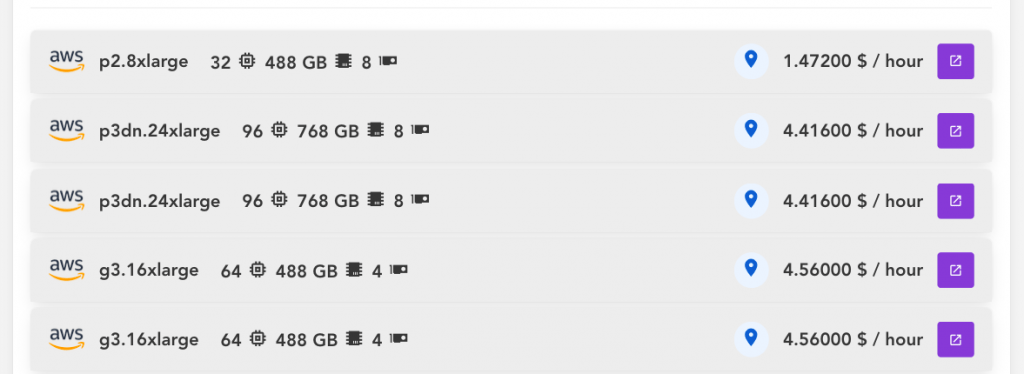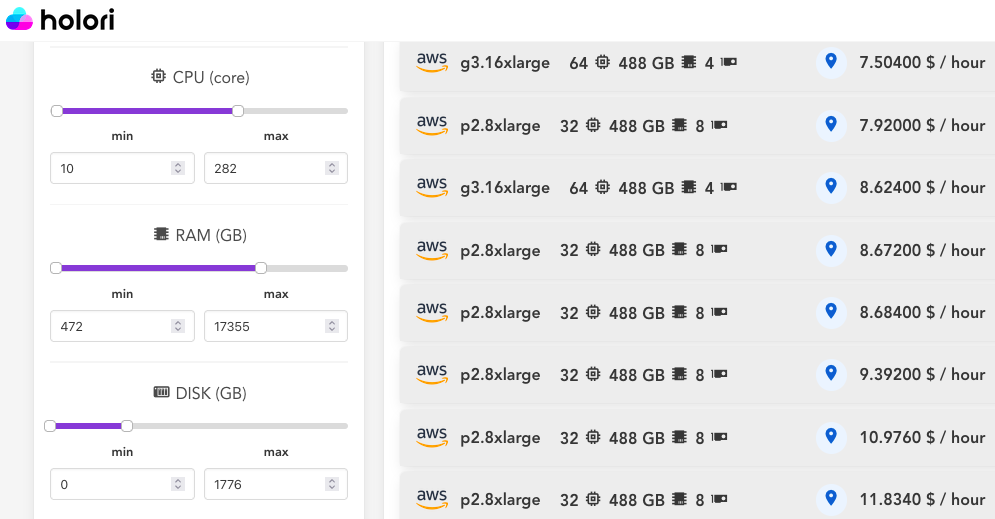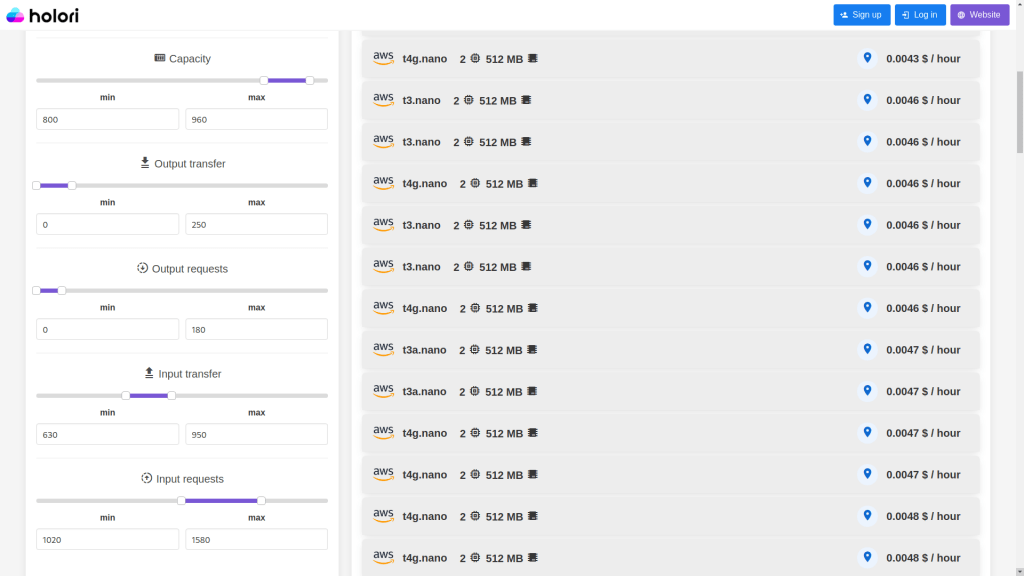Ultimate AWS Pricing Calculator
Define your AWS instance type requirements and estimate AWS costs

Holori AWS calculator compare the following instances
| Name | CPU | RAM | GPU | Average price/hour |
|---|---|---|---|---|
| for all locations in USD" | ||||
| a1.2xlarge | 8 | 16 | 0 | $0,38 |
| a1.4xlarge | 16 | 32 | 0 | $0,59 |
| a1.large | 2 | 4 | 0 | $0,12 |
| a1.medium | 1 | 2 | 0 | $0,08 |
| a1.metal | 16 | 32 | 0 | $0,52 |
| a1.xlarge | 4 | 8 | 0 | $0,19 |
| c1.medium | 2 | 2 | 0 | $0,25 |
| c1.xlarge | 8 | 7 | 0 | $0,77 |
| c3.2xlarge | 8 | 15 | 0 | $1,25 |
| c3.4xlarge | 16 | 30 | 0 | $3,97 |
| c3.8xlarge | 32 | 60 | 0 | $6,58 |
| c3.large | 2 | 4 | 0 | $0,26 |
| c3.xlarge | 4 | 8 | 0 | $1,3 |
| c4.2xlarge | 8 | 15 | 0 | $1,85 |
| c4.4xlarge | 16 | 30 | 0 | $2,81 |
| c4.8xlarge | 36 | 60 | 0 | $5,55 |
| c4.large | 2 | 4 | 0 | $0,4 |
| See more on Holori cloud calculator |
AWS pricing calculator to estimate compute costs
What is AWS EC2?
AWS EC2 (Amazon Elastic Compute Cloud) is AWS most famous product. Amazon EC2 is a web-based service that allows you to securely rent computing power to run your applications.
The main advantage of EC2 is the flexibility as users can scale or resize capacity within minutes and choose from a large variety of options: processor, storage, networking, operating system, deployed regions and purchase model.
AWS EC2 offers near 400 different instances, across a total of 24 regions and almost 80 availability zones through the world.
Here is our tutorial to better understand Holori AWS pricing calculator
1 – Define EC2 Requirements
EC2 instances are the major drivers of your cloud bill and it’s therefore key to carefully select them and estimate their costs.
Our AWS pricing calculator offers the possibility to specify your requirements and find the appropriate EC2 instance.
You can adjust the following parameters in Holori AWS calculator:
CPU – GPU – Memory – Price – Storage – Location – OS
2 – How to select the right AWS EC2 Instance type?
The main EC2 instance types are:
– General Purpose: The most popular; used for web servers, development environments, etc. They are a good way to start when beginning on AWS
Type : A1, M5, T3/T3a, T2, M6G, M5A, M5N, M4
– Compute Optimized: Good for compute-intensive applications such as scientific modeling or high-performance web servers.
Type: C5, C4, c5N
– Memory Optimized: Good for anything that needs memory-intensive applications, such as real-time big data analytics or Hadoop/Spark clusters.
Type: X1, High Memory, Z1
– Accelerated Computing: If you need additional computing power, you can use dedicated resources such as GPUs, FPGAs Ex: Ethereum mining or machine learning.
Type: P3, G3, F1
– Storage Optimized: Convenient for tasks that require huge storage capacity
Type : I3 D2 H1
Holori AWS pricing calculator will narrow down the results for the most suitable EC2 instance type based on your requirements.

3 – Understand how to choose the right purchase model
There are 4 main purchase models for EC2 instances. Each of these purchase models will impact the EC2 pricing.
Reserved instances
By purchasing Reserved instances, you have a long-term commitment (1 to 3 years). RIs are very suitable for production applications with predictable workloads and high availability requirements. Reserved Instances grant you capacity reservation in a specific Availability Zone. The advantage is a very significant discount (up to 75%) compared to On-demand instance pricing.
On-demand instances
AWS on-demand instances pricing can be seen as “pay for what you use”. There is no commitment, it’s a “contract” that you can revoke at any time.
The billing on demand is made for greater flexibility as you can decide to scale or decrease capacity instantaneously and pay the specified hourly rates for the instance you use.
With Holori AWS pricing calculator you can choose from a large catalogue of instance types and adjust to make it very specific to your needs.
This purchase model is very suitable for short term applications or for unpredictable applications where traffic peaks are hard to forecast.
Spot instances
On Holori AWS pricing calculator you are able to find EC2 spot instances.
EC2 spot instances are spare capacity from AWS that you can purchase at an important discount compared to on-demand. Discount can go up to 90% making it the cheapest option to get EC2 capacity. The spot price of each instance type is different in each availability zone and varies based on supply and demand.
Saving plans
Similarly to Reserved instances, saving plans helps you to anticipate and plan your cloud budget with the advantage of bringing even more flexibility. Thus, you can commit to a EC2 compute spend per hour at a discount rate over 1 – 3 years. If your usage exceeds the commitment, AWS will charge the regular on-demand rates.
With Holori AWS pricing calculator you can see the price per hour up to a 3-year commitment period.
4 – Find the most suitable location
EC2 instance costs can vary greatly depending on the location of the server. Our AWS pricing calculator allows you to either identify the cheapest options for given locations or the cheapest location for your EC2 instance globally.
5 – Compare your AWS EC2 instances to other providers’ compute instances
Why should your AWS pricing calculator only be limited to AWS?
Holori cloud cost calculator lets you compare EC2 instances to other cloud providers compute instances. Based on your requirements you can compare AWS vs GCP, AWS vs Azure…

Guide to AWS Lambda pricing
AWS Lambda is a serverless compute service to run code without the need of provisioning or managing servers. With AWS Lambda you can create workload-aware cluster scaling logic, maintain event integrations, and manage runtimes easily. Lambda can run code for virtually any type of application or backend service, all with no administration, and only pay for what you use. You are charged based on the number of requests and the duration it takes for the code to execute.
Lambda counts a request each time it starts executing in response to an event notification trigger.
Duration is calculated from the time the code begins executing until it returns or otherwise terminates. The price depends on the amount of memory allocated to the function. In the AWS Lambda resource model, the user chooses the amount of memory wanted for its function, and are allocated proportional CPU power and other resources. An increase in memory size triggers an equivalent increase in CPU available to the function.
How much costs AWS Lambda?
The popularity of Lambda greatly relies on the fact that users only pay for what they use. The cost of AWS Lambda instances is therefore very interesting.
It costs as low as low as $0.2 for 1 million requests and $0.0000166667 for every GB-second (Prices vary with regions). Lambda pricing also includes a compute savings plan which can further lower costs up to 17%.
AWS Lambda is not yet part of Holori AWS pricing calculator but will arrive very soon.

How to use AWS Lightsail as an alternative to EC2?
AWS Lightsail pricing is designed to be low and predictable. Lightsail bundles resources like memory, vCPU, and solid-state drive (SSD) storage into one plan, to make budgeting easier. AWS Lightsail pricing plans include static IP addresses, domain name system (DNS) management, one-click secure shell protocol (SSH) terminal access (Linux/Unix), one-click RDP access (Windows), highly available SSD storage, and server monitoring.
Lightsail plans are billed on an on-demand hourly rate, so you pay only for what you use. For every plan you use, AWS charges the fixed hourly price, up to the maximum monthly plan cost. The least expensive Lightsail plan starts at $0.0047 USD/hour which equals to $3.50 USD/month.
Various outbound costs are included in lightsail instances, for example, each lightsail instance includes up to 7 TB of internet data transfer allowance depending on instance size.
Compared to EC2 instances, Lightsail offers way less configuration options which eases the instance choice and lowers the number of possible pricing combinations. Use Holori AWS cost calculator to compare the different prices.
Lightsail vs EC2
Where EC2 offers a huge number of configuration possibilities, Lightsail is designed for speed and simplicity. Lightsail instances run on top of EC2 and are bundled with other AWS resources, these services are however abstracted which makes it invisible to the user.
The nature of the package Lightsail offers makes it difficult to compare them with EC2.

Getting started with AWS Fargate
What is AWS Fargate?
AWS Fargate is a serverless compute engine for containers that is made for both Amazon Elastic Container Service (ECS) and Amazon Elastic Kubernetes Service (EKS). AWS Fargate simplifies building your applications. AWS Fargate also relieves you from provisioning and managing servers, it lets you specify and pay for resources per application. It also improves the overall security by isolating applications by design.
When using Fargate, you simply need to define the resources required by your application. Regarding payment, you will only pay for the resources that are required to run your containers, this reduces the risk of overprovisioning and spending more than needed.
EC2 vs AWS Fargate?
There are two ways of running your containers on AWS:
– EC2 (Deploy and manage your cluster of EC2 instances for running the containers)
– AWS Fargate (Run containers directly without EC2 instances)
Both solutions are perfectly viable to operate your containers in a scalable and reliable way. The decision to use one or the other depends on multiple factors.
How does AWS charge for Fargate service?
EC2 allows you to optimize price by choosing different purchase models or instance type such as spot instances, or reserved instances. Nevertheless, it remains the devs’ responsibility to ensure that containers are optimized to maximize the output not to waste money.
With AWS Fargate, cost is based on the number of CPU cores and GB of memory the task requires per second. The price is based on what the task uses unlike EC2 where capacity can sometimes be unused if not properly optimized.
You only ever pay for what your task uses, no more paying for EC2 capacity that goes unused.
Unlike EC2, AWS Fargate is not yet included in Holori AWS pricing calculator.
Understand AWS Beanstalk
AWS Beanstalk makes it easier for developers to quickly deploy and manage applications on AWS.
It simply requires uploading the application to AWS, Beanstalk then takes over, provisions the resources, and handles the configuration. The uploaded application will then be available with capacity provisioning, load balancing, auto-scaling, and health monitoring.
AWS Beanstalk pricing
Using AWS Beanstalk is virtually free since you do not pay for the service itself, but you pay for the resources used to power your application. The AWS Beanstalk pricing is based on the underlying resources and their configuration.
Benefits of AWS Beanstalk
AWS Beanstalk provisions and operates the infrastructure and manages the application stack for you, meaning that you don’t have to spend the time or develop the expertise yourself. Another advantage is also that it will keep the underlying platform running your application up to date with the latest patches and updates. You can then focus on writing code rather than spending time managing and configuring servers, databases, load balancers, firewalls, and networks.
AWS Beanstalk is not yet included in Holori AWS pricing calculator.
How Holori AWS pricing calculator helps you optimize AWS batch?
AWS Batch allows tech teams to run hundreds of thousands of batch computing jobs easily and efficiently on AWS. It dynamically provisions the optimal quantity and type of compute resources such as CPU or memory optimized instances based on the volume and specific resource requirements of the batch jobs submitted. It isn’t needed to install and manage batch computing software or server clusters to run jobs, allowing users to focus on analyzing results and solving problems.
AWS Batch plans, schedules, and executes batch computing workloads across the full range of AWS compute services and features, such as AWS Fargate, Amazon EC2 and Spot Instances.
There is no additional charge for AWS Batch. You only pay for the underlying AWS resources such as EC2 instances or Fargate jobs that you create to store and run your batch jobs.
Therefore, you can use Holori AWS pricing calculator to identify EC2 or Spot instances to estimate and optimize cloud costs.
See below the EC2 instances we compare in our AWS pricing calculator
For more details go to Holori AWS pricing calculator
AWS Pricing Calculator to estimate storage cost
Getting started with Amazon EBS
Amazon Elastic Block Store (AWS EBS) is a storage service made for Amazon EC2 instances. The user has the possibility to choose multiple workloads to deploy on Amazon EBS such as relational and non-relational databases, big data analytics engines, applications, containerized applications, file systems.
There are four different volume types that can be used with Amazon EBS to ensure that workloads are optimized in terms of pricing and performance. Some parameters can be adapted such as volume types, performance, volume size.
Each Amazon EBS volume is automatically replicated elsewhere in the same Availability Zone within the AWS region. This offers high availability (guaranteed 99.999% by Amazon) and redundancy.
How to choose AWS EBS volume type?
Two Types of AWS EBS Volumes exist: SSD-backed volumes and HDD-backed volumes.
SSD-backed volumes
SSD-backed volumes offer the best performance for transactional workloads requiring a lot of read/write operations. The unit to measure theses volumes is called IOPS (input/output operations per second.
SSD can then be divided into 2 volume types: gp2 General Purpose SSD and io1 EBS Provisioned IOPS SSD.
- The gp2 volume pricing is based on the amount provisioned monthly until the storage is released. The cost of a gp2 volume is $0,10/GB/month of storage provisioned.
- The io1 volume pricing is based on the amount provisioned monthly until the storage is released. The monthly pricing also considers the amount provisioned in IOPS (input/output operations per second).
The volume cost for provisioned IOPS (io1) is $0,125/GB/month for the provisioned storage and $0,065/provisioned IOPS/month.
HDD-backed volumes
HDD-backed volumes are most suitable for large sequential workloads requiring high quantity of data exchange. The volumes are measured un MiB/s.
Two different volume types are available: Throughput Optimized HDD (st1), and Cold HDD (sc1).
- Volume storage for Throughput Optimized HDD (st1) volumes is invoiced by the amount provisioned in GB/month until the storage is released. The cost of Throughput Optimized HDD (st1) Volumes is $0.045/GB/month of provisioned storage.
- Regarding the Volume storage for Cold HDD (sc1), the cost is based on the amount provisioned in GB/month until the storage is released. The price of Cold HDD (sc1) volumes is $0.025/GB/month of provisioned storage.
How to forecast AWS EBS costs in Holori AWS pricing calculator?
Using Holori AWS pricing calculator you can easily define your requirements and identify the best EBS storage disk.
In a generic way, users are able to define the storage capacity they need, the output transfer rate, the output request number as well as the input transfer rate and number of input request. Holori AWS calculator will narrow down the results helping you in the decision process.
What is AWS S3?
AWS S3, that stands for Simple Storage Service is the most famous cloud object storage product given its durability, availability, and scalability.
S3 object storage is built to store and retrieve any amount of data from anywhere.
This service can be used by any type of user or application, the entire S3 concept is built around Bucket and Object. An Object includes all the metadata that come with a file (its name, size…), this object must be in a container called a bucket. To make it easier to understand, you can have multiple buckets each containing a very large number of objects.
In a nutshell Amazon S3 is good at storing large numbers of backups or files. Unlike EBS or EFS, S3 is not limited to EC2.
Benefits of AWS S3
Performance and availability: AWS S3 offer its service access to the users with the same highly scalable, reliable, fast, inexpensive data storage infrastructure. S3 Standard is designed for more than 99.99% availability making it a very good choice for users with critical applications.
Security: AWS S3 buckets are usable on a permission-based level that is managed through the IAM policy of the AWS account.
Cost savings: Using S3 to store data helps the users save costs and ensure a high level of performance.
How to select the right S3 Storage type?
There are six main AWS S3 storage types depending on your constraints.
S3 Standard Storage
As its name describes it AWS S3 Standard Storage is convenient for standard storage use cases where you may need to regularly access data. As you pay per use, S3 Standard Storage is convenient for most cases especially for data-intensive or user-generated content.
S3 Infrequent Access Storage
S3 Infrequent Access Storage is suitable for storing data that do not need to be regularly accessed, but that stills needs to be accessible quickly if an emergency occurs. In terms of pricing, the AWS S3 cost for Infrequent Access Storage costs less than Standard Storage, accessing or retrieving data however has a higher cost.
S3 One Zone Infrequent Access Storage
AWS usual policy when data is assigned to a region is to share it across a minimum of 3 availability zones to ensure recovery. One Zone Infrequent Access Storage is perfect for data that doesn’t need to be frequently accessed but still must be rapidly retrieved and can accept lower availability. The One Zone Storage will store data only in one availability zone thus resulting in a lower cost than can represent up to a 20% discount.
S3 Glacier Storage
S3 Glacier has been designed for long-term data archiving and is often suitable to meet compliance requirements of long-term data storage. It can take up to several hours for retrieval requests to be performed making it unsuitable for applications requiring quick data access.
S3 Glacier Deep Archive
Another option for data that rarely needs to be accessed (1 – 2 times/year) is to opt for S3 Glacier Deep Archive. It is a very good cost-saving option even if data retrieval requests can take up to half a day to be completed.
S3 Intelligent Tiering
For users who need to have long and short-term storage at the same time, AWS offers an intelligent tiering service to automatically transfer data between Standard S3 and Standard Infrequent tiers. If an object hasn’t moved in 30 days, the tiering service will transfer it to the Standard Infrequent tier storage.
With Holori AWS pricing calculator you are able to define your storage requirements (long-term or frequent access) and narrow down the results of all the storage types.
AWS S3 Pricing
The pricing of AWS S3 depends on several factors that must be considered when looking at data storage and management topics. The 6 pricing factors are: storage, request and data retrieval, data transfer and transfer acceleration, data management and analytics, and the price to process data with S3 Object Lambda.
Holori AWS pricing calculator doesn’t yet include AWS S3. For more details on the pricing go visit: https://aws.amazon.com/s3/pricing
What you need to know about AWS EFS
Amazon Elastic File System (Amazon EFS) is an elastic file system designed to be simple, serverless with a set-and-forget mindset. AWS EFS doesn’t come with a minimum fee or setup charge. Users only pay for the storage used, for read and write access to data stored in Infrequent Access storage classes, and for any provisioned throughput.
AWS EFS is divided into four storage classes: two standard storage classes (Amazon EFS Standard and Amazon EFS Standard-Infrequent Access / EFS Standard-IA), and two One Zone storage classes (EFS One Zone and Amazon EFS One Zone-Infrequent Access / EFS One Zone-IA).
AWS EFS file system is very well suited to be used as a managed network file system, it can be shared across different Amazon EC2 instances. It also works like NAS devices and can be used for various applications such as content management, data analytics or media processing…
How much does AWS EFS cost?
AWS EFS pricing depends on various factors. The standard storage is priced be GB and costs $0,30/GB/month, the Standard-infrequent Access Storage is priced at $0,025/GB/month. The One Zone Storage costs $0,16/BG/month for standard access and $0,0133 if you choose the infrequent access storage. In addition to that, AWS will also charge you per requests and for the Provisioned Throughput. Use Holori AWS costs calculator to identify the best option.
All about AWS FSX
Amazon FSx for Windows File Server offers a fully managed, highly reliable, and scalable file storage built on Windows Server.
There are 2 main options when selecting an AWS FSx: FSx Windows File Server or FSx for Lustre.
The first one, AWS FSx Windows file server offers a standard and fully managed Microsoft Windows file system making it simple to move and migrate windows-based workloads that require file storage. Technically the solution is based on Windows Server and operates as shared file storage. It can be used for a large range of administrative features such as user quotas, end-user file restore, and Microsoft Active Directory (AD) integration. It offers single-AZ and multi-AZ deployment options, fully managed backups, and encryption of data at rest and in transit.
Amazon FSx for Lustre is also a fully managed file system but this time it is specifically thought for compute-intensive workloads. Its sweetspot is around applications requiring high performance such as machine learning for example since it can easily process very large data sets.
AWS FSx pricing
The cost and performance of AWS FSx services can be optimized depending on your expected usage. You can for example choose between SSD and HDD storage options for your workload. AWS make it easy to scale storage and change the throughput performance of the file system whenever required.
As usual with other AWS storage services, the AWS FSx pricing is based on the following variables: Storage capacity, throughput capacity, backups and Data transfer.
For example SSD storage costs $0,130/GB/month when HDD is at $0,013/GB/month and the throughput capacity is priced at $2.200/MBps/month.


